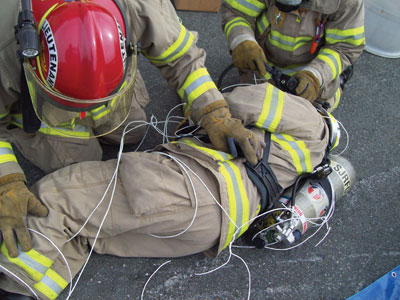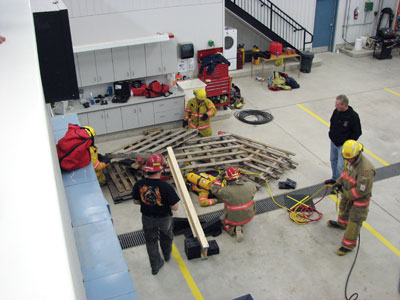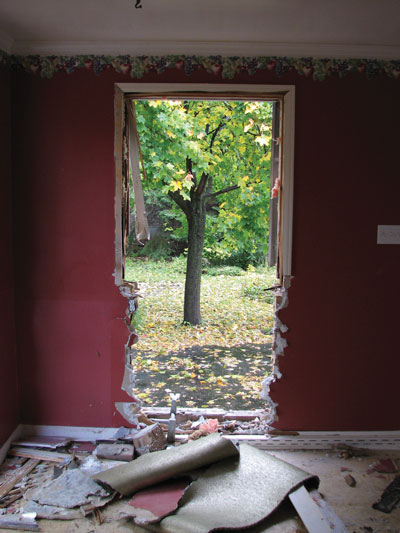
Back to Basics: January 2011
Mark Van
Features Fire Ground TrainingDuring rapid intervention team (RIT) operations, it’s important to consider ways to increase the mayday firefighter’s chances of survival. This can be done by applying the AWARE acronym to every rescue of a mayday firefighter: Air, Water, A Radio and Extrication. This acronym helps the incident commander with the RIT operation and it will help RIT members remember what to address first, second, third and last with respect to the rescue. We have already looked at air, water and radio. Now we’ll look at extrication.
During rapid intervention team (RIT) operations, it’s important to
consider ways to increase the mayday firefighter’s chances of survival.
This can be done by applying the AWARE acronym to every rescue of a
mayday firefighter: Air, Water, A Radio and Extrication. This acronym
helps the incident commander with the RIT operation and it will help
RIT members remember what to address first, second, third and last with
respect to the rescue. We have already looked at air, water and radio.
Now we’ll look at extrication.

|
| The St. John’s Regional Fire Department practises sweeping for and removing any entanglements that may be found on the mayday firefighter. (Photos by Mark van der Feyst)
|
Extrication
Once contact has been made with the mayday firefighter, and a source of
air and a defendable space to survive have been provided, the
firefighter needs to be extricated. Several factors may contribute to
or hinder the operation. A mayday firefighter who is found not
breathing for a medical reason rather than a mechanical reason needs to
be extricated immediately in a grab-and-go style extrication. It is
important to get the mayday firefighter out of the structure to start
proper medical treatment. If the mayday firefighter is breathing on his
own, take the time to assess, package and remove.
 |
|
| A lifting operation is being set up and performed to free the trapped/pinned firefighter. | |
 |
|
| An enlarged opening created by using a window. By doing this, the exit point will be closer, resulting in faster extrication. |
Entanglements
The rapid intervention team’s ability to extricate is hindered when a
firefighter gets tangled in wires, a suspended ceiling grid, curtains
or HVAC duct work. Assessing, packing and preparing the firefighter for
removal while he is still tangled in a mess of wires, is not
beneficial. Trying to remove a firefighter who is still tied to the
building wastes time. Make sure the firefighter is not tangled by
conducting a sweep of the body to check for any possible entanglements.
This can be done by one of the RIT firefighters (as seen in photo 1).
Trapped/pinned
Time also work against RIT members if a mayday firefighter is trapped
or pinned by a part of the building. In a residential structure,
firefighters can be trapped by part of the ceiling, part of the roof,
part of the floor above them or heavy pieces of furniture. In a
commercial or industrial type of building, objects trapping or pinning
a firefighter are much heavier, such as L-beams, pieces of machinery,
bar joists or parts of concrete walls or floors. These objects present
a challenge for the RIT and need to lifted off the mayday firefighter
using a variety of extrication tools. A lifting operation requires
cribbing, extrication tools and manpower.
Location of the mayday firefighter
Determining the location of a trapped, lost/missing or injured
firefighter is crucial. If the mayday firefighter can communicate, he
can tell command where he is, but this is contingent on the mayday
firefighter being aware of his surroundings. It is easy to become
disoriented when a catastrophic event, such as a collapse, occurs. The
firefighter may be turned around or moved away from a landmark and this
can confuse the firefighter. Listening to the PASS alarm will help to
locate the mayday firefighter. It is important to remember to have the
mayday firefighter activate his PASS alarm.
If the mayday firefighter is unable to communicate with command, trying
to figure out his last location depends on the established
accountability system. If proper and current tracking is happening with
accountability, RIT members will be able to determine the last location
and the search can begin there.
Number of mayday firefighters
Generally, in RIT operations, just one firefighter needs to be rescued.
When conducting interior structural fire operations, a minimum of two
firefighters operate together. It’s important to think about the number
of firefighters who need to be rescued. If there is more than one, more
resources and equipment are required. A study conducted by the Phoenix
Fire Department found that, on average, it takes 22 minutes and 12
firefighters to rescue one firefighter. Rescuing two firefighters
requires twice as many firefighters.
Nearest exit
After the mayday firefighter has been assessed and packaged for
removal, he must be removed from the structure. The exit point does not
have to be the same entry point used by the RIT. It is quicker to
create a new exit point closer to the location of the mayday
firefighter. Building features, such as a window, can be enlarged to
remove the mayday firefighter. Once contact has been made with the
mayday firefighter, the RIT officer should establish the nearest exit.
A separate crew can be assigned to enlarge the opening while assessment
and packaging are taking place.
When extricating a mayday firefighter, use time wisely to increase
chances of the best outcome. RIT success comes with much practice and
training on certain removal techniques, which we will discuss next
time.
Mark van der Feyst is an 11-year veteran
of the fire service. He currently works for the City of Woodstock Fire
Department in Ontario. Mark is an international instructor teaching in
Canada, the United States and India. He is a Local Level Suppression
Instructor for the Pennsylvania State Fire Academy, an Instructor for
the Justice Institute of British Columbia and a professor of fire
science at Lambton College. E-mail him at Mark@FireStarTraining.com.
Print this page